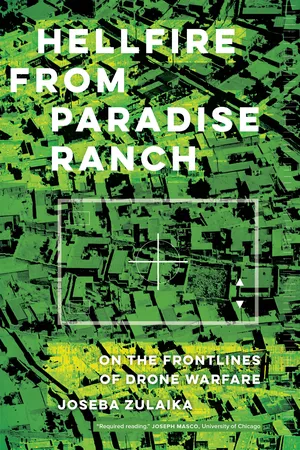
- 296 pages
- English
- ePUB (mobile friendly)
- Available on iOS & Android
About this book
In this intimate and innovative work, terror expert Joseba Zulaika examines drone warfare as manhunting carried out via satellite. Using Creech Air Force Base near Las Vegas as his center of study, he interviews drone operators as well as resisters to the war economy of the region to expose the layers of fantasy on which counterterrorism and its self-sustaining logic are grounded.
Hellfire from Paradise Ranch exposes the terror and warfare of drone killings that dominate our modern military. It unveils the trauma drone operators experience, in part due to their visual intimacy with their victims, and explores the resistance to drone killings in the same apocalyptic Nevada desert where nuclear testing, pacifist militancy, and Shoshone tradition overlap.
Stunning and absorbing, Zulaika offers a richly detailed account of how we continue to manufacture, deconstruct, and perpetuate terror.
Frequently asked questions
- Essential is ideal for learners and professionals who enjoy exploring a wide range of subjects. Access the Essential Library with 800,000+ trusted titles and best-sellers across business, personal growth, and the humanities. Includes unlimited reading time and Standard Read Aloud voice.
- Complete: Perfect for advanced learners and researchers needing full, unrestricted access. Unlock 1.4M+ books across hundreds of subjects, including academic and specialized titles. The Complete Plan also includes advanced features like Premium Read Aloud and Research Assistant.
Please note we cannot support devices running on iOS 13 and Android 7 or earlier. Learn more about using the app.
Information
1
The Real
HOME OF THE HUNTERS
A RADIO EXCHANGE
SENSOR: | Looks like people on the back of a pickup, one, two, three, at least five dudes so far. . . . That truck would make a beautiful target. |
PILOT: | Yeah. |
MC. | Screener said at least one child near SUV. |
SENSOR: | Bullshit. Where? I don’t think they have kids out at this hour, I know they’re shady but come on. |
. . . . | |
MC: | They are reviewing. |
PILOT: | Okay, review that shit. Why didn’t he say possible child, why are they so quick to call fucking kids but not to call a fucking rifle. |
SENSOR: | I really doubt that “children” call, man. I really fucking hate that. |
SENSOR: | Picked up a third vehicle on their train. |
MC: | Guilty by association. |
. . . . | |
SENSOR: | They’re praying. They are praying. Praying? I mean, seriously, that’s what they do. |
MC: | They’re going to do something nefarious. |
. . . . | |
MC: | Adolescent near the rear of the SUV. |
SENSOR: | Well, teenagers can fight. |
MC: | Pick up a weapon and you’re a combatant. It’s how that works. |
PILOT: | . . . Be advised, all passengers are finishing up praying, and rallying up near all three vehicles at this time. |
SENSOR: | Oh, sweet target. I’d try to go through the bed [people lying on a bed at the back of the truck], put it right center of the bed. |
MC: | Oh, that’s perfect. |
PILOT: | . . . Our screeners are currently calling. |
PILOT: | Twenty-one MAMs [military-aged males], no females, and two possible children. |
JAG25: | Roger. When we say children are we talking teenagers or toddlers? |
SENSOR: | I would say about twelve, not toddlers. Something more towards adolescents or teens. |
JAG25: | We’ll pass that along to the ground force commander. But like I said, twelve-thirteen years old with a weapon is just as dangerous. |
SENSOR: | Oh, we agree. Yeah. |
MC: | What’s the master plan, fellas? |
PILOT: | I don’t know. Hope we get to shoot the truck with all the dudes in it. |
SENSOR: | Yeah. . . . Sensor is in, the party begins! |
PILOT: | Yeah. All right, so the plan is, man, uh, we’re going to watch this thing go down, the hells [Hellfire missiles] are going to take out as much as they can, and when they Winchester we can play cleanup. |
SENSOR: | Hey MC. |
MC: | Yes? |
SENSOR: | Remember, kill chain! |
MC: | Will do. |
SENSOR: | Roger. And |
EXPLOSION | |
SENSOR: | Oh . . . And there it goes! |
PILOT: | Our engagement. |
SENSOR: | Stand by. |
. . . . | |
PILOT: | They took the first [truck] and, uh, the last out. They’re going to come back around. |
SENSOR: | Looks like they’re surrendering. They’re not running. |
SAFETY OBSERVER: | Dude, this is weird. |
SENSOR: | They hit it. [Explosion of the third truck]. You . . . These guys are just . . . |
PILOT: | Holy shit. |
SENSOR: | I don’t know about this. This is weird. |
PILOT: | The lady is carrying a kid, huh? Maybe. |
MC: | No. |
SENSOR: | Huh, yeah. |
MC: | The baby, I think on the right. Yeah. |
PILOT: | Since the engagement we have not been able to PID [identify] any weapons.14 |
Table of contents
- Title
- Copyright
- Contents
- Prologue: Slaughterhouse-359
- 1. The Real: Home of the Hunters
- 2. Fantasy and the Art of Drone Assassination
- 3. Drone Wars Returning from the Future
- 4. Trauma: The Killer as Voyeur
- 5. Resistance: A Harsh and Dreadful Love
- Epilogue: Obama’s Troy: Kill Me a Son
- Acknowledgments
- Notes
- Bibliography
- Index